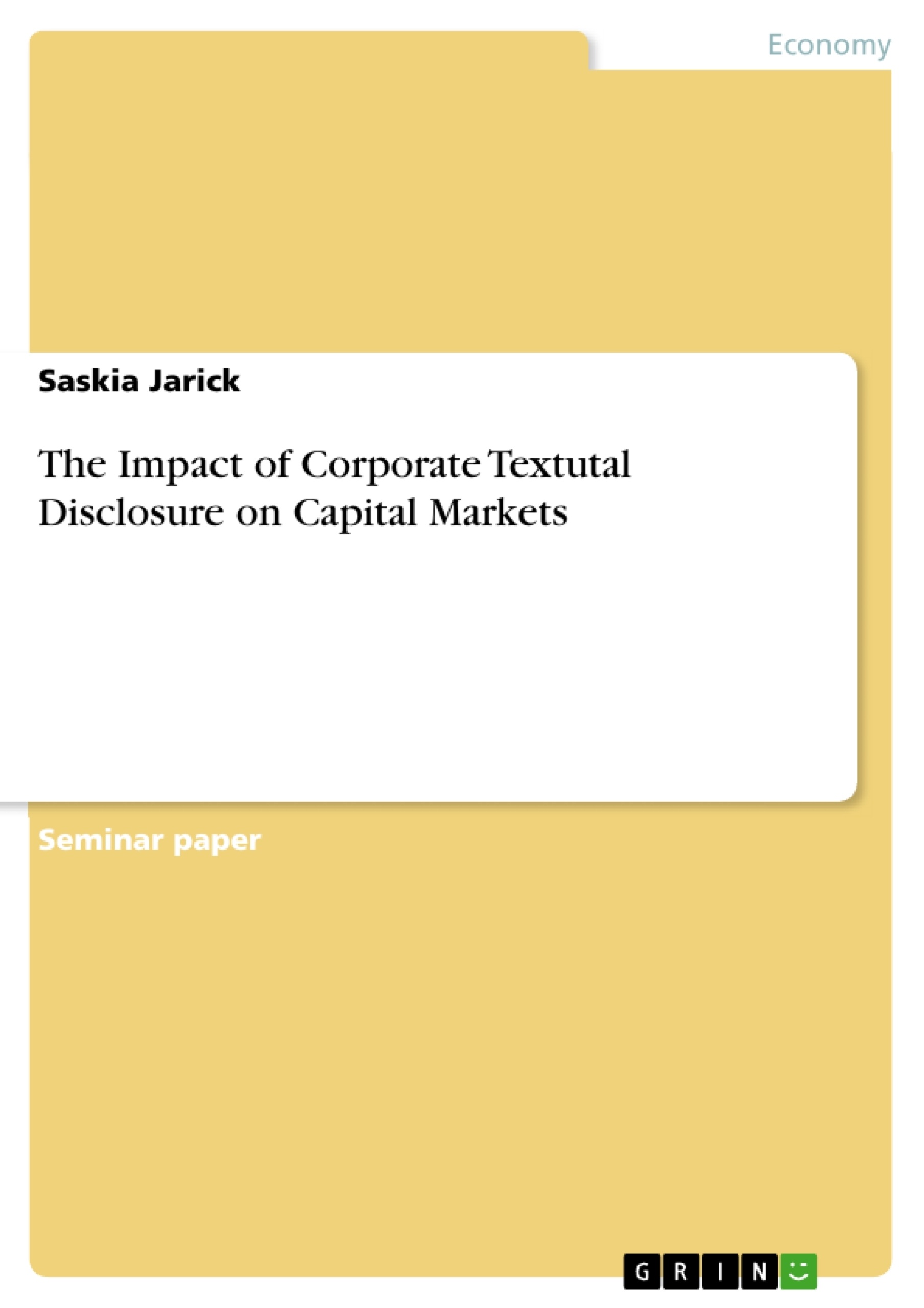Each year, firms disclose information that is analyzed and eventually reflected in the market price. Sources of information are for example annual reports, earnings announcements and press releases. In the past, financial accounting research focused primarily on the numerical financial information disclosed (cf. Hales et al. 2011, 224).1 Interestingly, research showed that asset price movements could only partly be explained by this quantitative information and thus must have additional influencing factors (cf. Demers/Vega 2010, 2).
Since corporate disclosure generally consists only to a small fraction of qualitative data and dominantly of textual information (cf. Li 2011, 1)2, and since language is the natural medium through which people communicate, financial accounting research started to focus on the analysis of textual disclosure (cf. Hales et al. 2011, 224). Results of these studies show that different aspects of textual disclosure, like the tone (how information is written/expressed) or the readability can influence for example market prices or analyst behavior (e.g. Li 2010 or Tetlock/Saar-Tsechansky/Macskassy 2008).
This paper focuses on research in the field of tone as important characteristic of corporate textual disclosure. Its aim is to provide an overview about the most recent approaches and about challenges that researchers face.
The remainder of this paper proceeds as follows. In section 2 the importance of textual analysis and the information content of textual information are discussed. Furthermore this section provides an overview about different approaches to characterize textual disclosure and a tabular classification of the recent literature. Since this paper focuses on the tone of textual disclosure, different approaches to measure tone are discussed as well. In section 3 two recent studies are discussed and section 4 concludes with a summary of the main results of this paper and gives suggestions for future research.
Inhaltsverzeichnis (Table of Contents)
- Introduction
- Theoretical Framework
- Importance of textual analysis
- Information content of textual disclosure
- Characteristics of textual disclosure
- Approaches of textual analysis
- Manual vs. computer-based approach
- Dictionary approach vs. statistical approach
- Recent Studies
- Feldman et al. (2010)
- Data, Sample Selection and Variable Definition
- Results
- Business Impact
- Hales et al. (2011)
- Hypotheses and Design of Experiment 1
- Results of Experiment 1
- Hypotheses and Design of Experiment 2
- Results of Experiment 2
- Business Impact
- Feldman et al. (2010)
- Conclusion and future challenges
Zielsetzung und Themenschwerpunkte (Objectives and Key Themes)
This seminar paper aims to examine the impact of corporate textual disclosure on capital markets. The study focuses on analyzing the information content of textual disclosure in financial statements, particularly the Management Discussion and Analysis (MD&A) section, and its influence on investor decision-making and market efficiency.
- Importance of textual analysis in financial reporting
- Information content of textual disclosure and its relation to market reactions
- Influence of textual disclosure on investor behavior and capital market efficiency
- Application of different textual analysis approaches
- Evaluation of recent research findings on the impact of textual disclosure
Zusammenfassung der Kapitel (Chapter Summaries)
The introduction presents the research problem and the rationale for exploring the impact of corporate textual disclosure on capital markets. It outlines the objectives and key themes of the study, highlighting the importance of textual analysis in financial reporting.
The theoretical framework chapter delves into the concept of textual analysis and its relevance in financial reporting. It explores the information content of textual disclosure, particularly the MD&A section, and examines the characteristics of textual disclosure, emphasizing the role of tone and sentiment. The chapter also reviews different approaches to textual analysis, including manual and computer-based methods.
The recent studies chapter provides a comprehensive review of existing literature on the impact of textual disclosure. It analyzes two prominent studies by Feldman et al. (2010) and Hales et al. (2011), presenting their methodologies, results, and business implications. The analysis focuses on the relationship between textual disclosure and investor behavior, market efficiency, and firm performance.
The conclusion chapter summarizes the main findings of the study and discusses the limitations of the research. It also identifies potential avenues for future research, highlighting the ongoing development and application of textual analysis techniques in finance and accounting.
Schlüsselwörter (Keywords)
This seminar paper explores the key concepts of textual analysis, information content, textual disclosure, MD&A, investor behavior, market efficiency, firm performance, and financial reporting. It also focuses on the application of different textual analysis approaches, including manual and computer-based methods, as well as the analysis of recent research findings on the impact of textual disclosure.
- Citar trabajo
- Saskia Jarick (Autor), 2011, The Impact of Corporate Textutal Disclosure on Capital Markets, Múnich, GRIN Verlag, https://www.grin.com/document/174775



